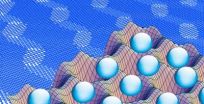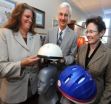(Press-News.org) A study published by Andrea Vanossi, Nicola Manini and Erio Tosatti - three SISSA researchers - in PNAS (Proceedings of the National Academy of Sciences) provides a new tool to better understand how sliding friction works in nanotribology, through colloidal crystals.
By theoretically studying these systems of charged microparticles, researchers are able to analyze friction forces through molecular dynamics simulations with accuracy never experienced before.
"There are several and very concrete potentialities", stated Andrea Vanossi, one of the members of the research group. "Just think of the constant miniaturization of high-tech components and of all the different nanotechnology sectors: if we understand how friction works at these levels, we will be able to create even more effective molecular motors or functional microsystems".
Colloidals are part of our everyday life (e.g. milk, asphalt or smoke) and they differentiate according to the state of the dispersed and dispersing substance (liquid, solid or gaseous).
The simulations were performed by SISSA in collaboration with ICTP, the Department of Physics in Milan and the CNR-IOM Institute for Materials Manufacturing and they allowed understanding what happens when a colloidal monolayer slides against an optical reticle modifying some parameters such as surface corrugation, drift speed or contact geometry.
The research method is also something new. Before this simulation was performed, only some recent experiments carried out in Germany tried for the first time to describe the behaviour of individual particles of a colloid in friction conditions, but never in such a precise way.
More in detail, researchers also suggest a way to directly extract the energy lost in friction by using the sliding data of the colloid. "This study is innovative also because it will allow predicting the different regimes of static friction realized according to the density of colloids and the strength of the optical reticle", added Erio Tosatti, another member of the research group. "All this lets us assume that crystalline solid surfaces will act in a similar way. We have never been able to make such a hypothesis before".
This study will open the way to new systems to explore the complexity of similar events, maybe at a microscopic scale.
INFORMATION:
What if the nanoworld slides
A new study to better understand how friction works
2012-11-08
ELSE PRESS RELEASES FROM THIS DATE:
The brain of OCD sufferers is more active when faced with a moral dilemma
2012-11-08
Patients with obsessive-compulsive disorder are characterised by persistent thoughts and repetitive behaviours. A new study reveals that sufferers worry considerably more than the general population in the face of morality problems.
Along with the help of experts from the Barcelona's Hospital del Mar and the University of Melbourne (Australia), researchers at the Hospital de Bellvitge in Barcelona have proven that patients with obsessive-compulsive disorder, known as OCD, are more morally sensitive.
"Faced with a problem of this type, people suffering from this type ...
Cambridge software improves quality of sound for hearing aid users
2012-11-08
A new software product developed by researchers at the University of Cambridge could greatly improve sound perception for users of hearing aids.
The software prescribes the amount of amplification of high-frequency sounds required to restore the audibility of such sounds. This increases the frequency range of sound that individuals with hearing loss are able to detect, improving speech perception, sound localisation and the ability to hear certain musical sounds, when compared with current methods. Results of an evaluation of the software were published recently in the ...
New habitable zone super-Earth found in exosolar system
2012-11-08
Washington, D.C.—Astronomers have discovered a new super-Earth in the habitable zone, where liquid water and a stable atmosphere could reside, around the nearby star HD 40307. It is one of three new super-Earths found around the star that has three other low-mass planets orbiting it.
HD 40307 is a dwarf star that is somewhat smaller and less luminous than the Sun that is about 42 light years away (12.88 parsecs). The previously discovered planets around it are called hot super-Earths because they orbit too close to the star to support life.
The international team, including ...
Study: Education levels in Asian American neighborhoods affect residents' health
2012-11-08
WASHINGTON, DC, November 8, 2012 — Higher neighborhood education is associated with better self-rated health among Asian Americans who live in Asian ethnic neighborhoods, but this correlation between individual health and neighborhood education levels does not exist for Asian Americans living in non-Asian neighborhoods, according to a recent study in the Journal of Health and Social Behavior.
"When Asian Americans live in neighborhoods that are not Asian ethnic neighborhoods, the education level of the neighborhood doesn't affect their health," says Emily Walton, an ...
Making memories: Drexel researchers explore the anatomy of recollection
2012-11-08
What was your high school mascot? Where did you put your keys last night? Who was the first president of the United States?
Groups of neurons in your brain are currently sending electromagnetic rhythms through established pathways in order for you to recall the answers to each of these questions. Researchers in Drexel's School of Biomedical Engineering, Science and Health Systems are now getting a rare look inside the brain to discover the exact pattern of activity that produces a memory.
Dr. Joshua Jacobs, a professor in Drexel's School of Biomedical Engineering, ...
Going with your gut
2012-11-08
Decision-making is an inevitable part of the human experience, and one of the most mysterious. For centuries, scientists have studied how we go about the difficult task of choosing A or B, left or right, North or South — and how both instinct and intellect figure into the process. Now new research indicates that the old truism "look before you leap" may be less true than previously thought.
In a behavioral experiment, Prof. Marius Usher of Tel Aviv University's School of Psychological Sciences and his fellow researchers found that intuition was a surprisingly powerful ...
Inpatient brain injury education increases bike helmet use, study finds
2012-11-08
AUGUSTA, Ga. – A 30-minute brain injury education program taught in the hospital may increase children's use of bicycle helmets, Georgia Health Sciences University researchers report.
The researchers provided bicycle helmet safety and brain injury prevention information to 120 patients age 5 to 18 at Georgia Health Sciences Children's Medical Center and found that helmet usage increased by 72.5 percent within the first month following the program – from only 11 children reporting wearing a bicycle helmet on every ride to 98 always wearing helmets.
"This is a big step ...
Feel-good hormone helps to jog the memory
2012-11-08
This press release is available in German.
The feel-good hormone dopamine improves long-term memory. This is the finding of a team lead by Emrah Düzel, neuroscientist at the German Center for Neurodegenerative Diseases and the University of Magdeburg. The researchers investigated test subjects ranging in age from 65 to 75 years, who were given a precursor of dopamine. Treated subjects performed better in a memory test than a comparison group, who had taken a placebo. The study provides new insights into the formation of long lasting memories and also has implications ...
Capnography training video by BMC published in New England Journal of Medicine
2012-11-08
(Boston) – Physicians at Boston Medical Center (BMC) have developed a training video for health care providers about how to effectively use capnography to monitor ventilation and carbon dioxide levels for patients under anesthesia or conscious sedation. This is the sixth video published in the New England Journal of Medicine's Videos in Clinical Medicine section produced by BMC. It highlights the importance of using capnography to increase patient safety.
Capnography, which graphically monitors carbon dioxide concentration and measures ventilation and respiration, is ...
New cells found that could help save people's sight
2012-11-08
Eye experts and scientists at the University of Southampton have discovered specific cells in the eye which could lead to a new procedure to treat and cure blinding eye conditions.
Led by Professor Andrew Lotery, the study found that cells called corneal limbal stromal cells, taken from the front surface of the eye have stem cell properties and could be cultured to create retinal cells.
This could lead to new treatments for eye conditions such as retinitis pigmentosa or wet age-related macular degeneration, a condition which is a common cause of loss of vision in older ...
LAST 30 PRESS RELEASES:
Norbert Holtkamp appointed director of Fermi National Accelerator Laboratory
New agentic AI platform accelerates advanced optics design
Biologists discover neurons use physical signals — not electricity — to stabilize communication
Researchers discover that a hormone can access the brain by hitchhiking
University of Oklahoma researcher awarded funding to pursue AI-powered material design
Exploring how the visual system recovers following injury
Support for parents with infants at pediatric check-ups leads to better reading and math skills in elementary school
Kids’ behavioral health is a growing share of family health costs
Day & night: Cancer disrupts the brain’s natural rhythm
COVID-19 vaccination significantly reduces risk to pregnant women and baby
The role of vaccination in maternal and perinatal outcomes associated with COVID-19 in pregnancy
Mayo Clinic smartwatch system helps parents shorten and defuse children's severe tantrums early
Behavioral health spending spikes to 40% of all children’s health expenditures, nearly doubling in a decade
Digital cognitive behavioral treatment for generalized anxiety disorder
Expenditures for pediatric behavioral health care over time and estimated family financial burden
Air conditioning in nursing homes and mortality during extreme heat
The Alps to lose a record number of glaciers in the next decade
What makes a good proton conductor?
New science reporting guide published for journalists in Bulgaria
New international study reveals major survival gaps among children with cancer
New science reporting guide published for journalists in Turkey
Scientists develop a smarter mRNA therapy that knows which cells to target
Neuroanatomy-informed brain–machine hybrid intelligence for robust acoustic target detection
Eight SwRI hydrogen projects funded by ENERGYWERX
The Lundquist Institute and its start-up company Vitalex Biosciences Announces Strategic Advancement of Second-Generation fungal Vaccine VXV-01 through Phase 1 Trials under $40 Million Competitive Con
Fine particles in pollution are associated with early signs of autoimmune disease
Review article | Towards a Global Ground-Based Earth Observatory (GGBEO): Leveraging existing systems and networks
Penn and UMich create world’s smallest programmable, autonomous robots
Cleveland researchers launch first major study to address ‘hidden performance killer’ in athletes
To connect across politics, try saying what you oppose
[Press-News.org] What if the nanoworld slidesA new study to better understand how friction works



